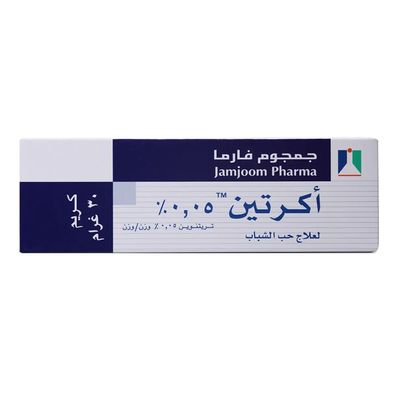
Acretin 0.05% Acne Treatment Cream 30 G
Product Details
What Tretinoin is Used For:
Tretinoin is a medicine that is used for the treatment of acne vulgaris, an inflammatory skin disorder known as common acne. It is caused by hair follicles that become plugged with oil and dead skin cells, resulting in blackheads, whiteheads, or pimples.
The safety and efficacy of the long-term use of this medicine in the treatment of other diseases have not been established.
Possible Side Effects:
Common side effects include skin burning or stinging, skin warmth, tingling, itching, dry skin, excessive skin redness, skin edema (fluid build-up), peeling of the skin, blistered skin, crusted skin, temporary change in color of the treated skin area (increased or decreased skin coloring), and increased sensitivity to sunlight.
These skin reactions usually subside when you stop using the medicine.
How to Use Tretinoin:
- Wash your skin gently with a mild, bland non-medicated soap two to three times daily and then pat skin dry with a towel.
- Let your skin dry 20 to 30 minutes before you apply the medicine.
- Avoid washing the affected area frequently and do not use harsh scrubs. Acne is not caused by dirt, therefore excessive washing and scrubbing will not remove it.
- Make sure that you use your cream exactly as prescribed by your doctor to get the best results. Be patient during your treatment as this medicine may take some time to start showing effect.
- Apply your tretinoin cream once daily before bedtime, or as directed by your doctor. Your doctor may recommend, particularly if you have sensitive skin, that you apply tretinoin every other night during the start of your therapy.
- First, start by washing the skin with a mild soap and dry your skin gently. Then, wait 20 to 30 minutes before you apply the cream to allow your skin to be completely dry to reduce possible skin irritation.
- To apply tretinoin cream, squeeze around a half inch or less of medication onto your fingertip. After you gain some experience with the cream, you may see that you should apply slightly more or less to apply enough of the medicine on your whole face.
- The cream applied is expected to become invisible almost immediately. If the cream is still visible, you are applying more than you should. In order to lightly cover the affected skin area with tretinoin cream, start by dabbing it on your chin, forehead, and both cheeks, then spreading it over the whole affected skin area, then smooth the applied cream gently into your skin.
- It is advised that you use a non-comedogenic (a product that does not worsen acne) moisturizer or a non-comedogenic moisturizer with sunscreen every morning after washing your skin.
- Avoid contact of the cream with your eyes, mouth, angles of the nose, and mucous membranes to avoid irritation at the site of application.